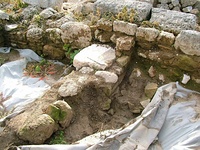| Collection: | Corinth | |
| Type: | Basket | |
| Name: | Nezi Field, context 10111 | |
| Area: | Nezi Field | |
| Context Type: | Wall | |
| Title: | Wall | |
| Category: | Cut | |
| Notebook: | 1103 | |
| 1104 | ||
| Context: | 10111 | |
| Page: | 0 | |
| Date: | 2009/02/19 | |
| Stratum: | 15-20% inclusions: tile, pottery, shell, fine-med. Pebbles | |
| Description: | The soil color is light greyish brown. It is clayey silt. Structure materials: reused squared limestone blocks, reused jurassic limestone road paving stone, cobbles, rooftile. Material size: max = 0.42 x 0.45 x 0.14; avg 0.15 x 0.25 x 0.8. Material finish: mostly unfinished. Material construction: random coursed rubble masonry. Material bonding: none. Features: none. | |
| Structure materials: Reused squared limestone blocks, reused jurassic limestone road paving sone, cobbles, roof tile. Material size: Varies widely; Max. road paving block=0.42 x 0.45. Material finish: Mostly unfinished. Material construction: Randon coursed rubble masonry. Material bonding: none. Features: none. | ||
| Notes: | This wall is being recorded as part of a plan to apply to have some walls removed in this part of the site to reveal the 11th c phase of a house for public display. This wall was revealed during excavations in 2008 with context 5623 but not given a context number at that time. The current state of preservation of this wall is fair; it survives to a higher elevation on its west end, where it bonds with wall 5724. More excavation is needed to fully reveal its eastern end to determine its length and relationship with features to the east, in particular, well 5876 and wall 5473. LATER NOTES (16/4/09): During removal of context 6115 (fill in a Byzantine-style subterranean pithos) foundations for wall 10111 revealed to be quite deep (at least 1.1m). Possible perpendicular jog of this wall uncovered in fragmentary form to north. It is also possible that wall 10111 also continues to room east, since it appears to line up with wall remains uncovered in this room. Thus, wall 10111 now appears to be earlier than most of the standing walls in these rooms. Now appears that wall 5472 built on top of wall 10111. Many of the blocks for this wall were recovered during removal of context 6115. Two other contexts (6112 & cut 6113, 6103 & cut 6106) may represent robbing trenches/pits for this wall. N-S jog to north now labeled as context 6130. Later notes: CMT/DPG (14-5-10): While removing the built pithos (6881), we uncovered remains of wall 10111 to the E of its documented location. It appears the pithos used part of the wall in the construction of the pithos( on the east and west of its circumference, moving some blocks to create a curve, while keeping the basic line of the wall). We took an elevation at the top of the preserved section on the western side of the pithos (263.11, 1036.99, 84.42). CMT/DPG 19-5-10: On 19 May 2010 we removed an extension of 10111, a pillar in the center of the room NW of the couryard in the Byzantine house, abutting the W of tile-built pithos 6881. It was removed because it posed a danger of collapsing. Additionally we are hoping it will yield pottery that may help date this wall. | |
| Alicia Carter Size of Material: Varies widely; Max. road paving block=0.42 x 0.45 x 0.14; Ave. cobble= 0.15m x 0.25 x 0.8 This wall is being recorded as part of a plan to apply to have some walls removed in this part of the site to reveal the 11th century AD phase of a house for public display. This wall was revealed during excavations in 2008 with context #5623 but not given a context number at the time. The current state of preservation of this wall is fair-it survives to a higher elevation on its west end where it bonds with wall #5742. More excavation is needed to fully reveal its east end to determine its length and relationship to features to the east, in particular, well #5876 and wall #5473. Later notes SG/WB (16/4/09): During removal of context 6115 (fill in a Byzantine-style pillar) foundations for wall 10111 revealed to be quite deep (at least 1.1m). Possible perpendicular jog of this wall uncovered in fragmentary form to north. It is also possible that wall 10111 also continues to room to east since it appears to line up with well remains uncovered in this room. Thus, wall 10111 now appears to be earlier than most of the standing walls in these rooms. Now appears that wall 5472 built on top of wall 10111. Many of the blocks for this wall were recovered during removal of context 6115. Two other contexts (6112 and cut 6113 and 6103 and cut 6106) may represent robbing trenches/pits for this wall. North-south jog to north now labeled as context 6130. | ||
| Context Pottery: | Coarseware. amphora. 1 bodysherd. ; Fineware. 1 bodysherd. | |
| Pottery Summary: | 1 frag(s) 0.01 kg. (0% saved) fineware. | |
| 17 frag(s) 0.36 kg. (0% saved) coarseware. | ||
| 7 frag(s) 0.04 kg. (0% saved) cooking ware. | ||
| Context Artifacts: | Tile Byzantine 1 | |
| Grid: | 261.97-260.87E, 1036.48-1037.13N | |
| XMin: | 260.87 | |
| XMax: | 261.97 | |
| YMin: | 1036.48 | |
| YMax: | 1037.13 | |
| Site: | Corinth | |
| City: | Ancient Corinth | |
| Country: | Greece | |
| References: | Report: Nezi Field 2009 by William Bruce, Scott Gallimore (2009-03-30 to 2009-04-16) Image: digital 2009 0134 Image: digital 2009 0135 Image: digital 2010 1110 |
|


